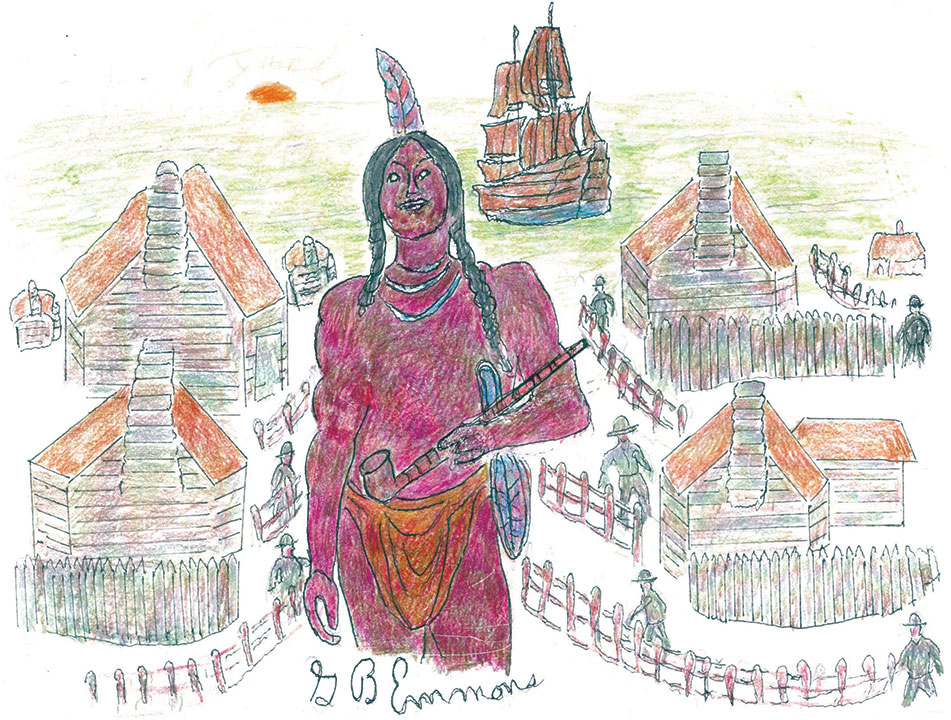It is now over 400 years since the Mayflower, with 101 men, women, and children reached land after 66 days of grueling passage at sea. However, they had gone off course from their planned destination at the mouth of the Hudson River. After exploring Cape Cod for a month, a storm blew them off course again into Plymouth Harbor. The harbor was so perfect for settlement that they decided to build there beginning on Christmas day in 1620. They said their praises to God for bringing them to such a welcoming destination, almost waiting for their arrival.
Actually, the site had been a thriving Wampanoag village known as Patuxet, abandoned the year before when a plague brought by European explorers swept the coast of Indians who had no immunity to its disease. There weren’t even enough survivors to bury the dead, and they left behind corn storage pits, beads, baskets, and pots, all abandoned.
When the Pilgrims began to build, Wampanoag Chief Massasoit, the chief of the coastline villages and tribes that had been decimated, came to visit Governor John Carver to question their intentions and managed to negotiate a peace pact beneficial for both settlers and natives.
Since Massasoit’s tribes were so badly decimated, the chief hoped that, by treaty with the Pilgrims, he would be strong enough to thwart an invasion by the Narragansetts that lived far enough inland not be touched by the plague. This agreement served both parties throughout the rest of Massasoit’s life. In his old age, the English King James sent Massasoit a solid silver smoking pipe as a gift for having saved his most recent vulnerable colony in the new world. However, half of the colonists died from hunger and disease in the first winter, but in spring, Wampanoags told the rest how to plant crops and live off the land.
Massasoit and his men kept a close watch on the new colony, including Squanto, who spoke English and moved near the village to act as a translator. The Wampanoags were known as the “people of the dawn.” They were the first to see the sunrise out of the sea, where they gathered an abundance of food, including mussels, clams, and quahaugs whose shells were made into wampum beads of a currency.
The Pilgrims farmed so well during the fall of 1621 that they decided to celebrate a successful and bountiful harvest with the first Thanksgiving. Long before that, the Wampanoags had always had autumn festivals. One was the strawberry festival and another the green corn thanksgiving, both celebrated with song and dance. Massasoit was invited and came with no less than 100 men. It was not a religious ceremony, but one that lasted all of three days of feasting together and joining in games and other activities of mutual celebration.
The Pilgrims had sailed across the sea to practice an ideology of freedom of religion, but the Massachusetts Bay colony in Boston ejected Roger Williams for heresy in the Puritan doctrine of commandment, for preaching that all the land belonged to the Indians, who should be paid for its use or ownership. He escaped extradition by going to the lodge of Massasoit to spend the winter and bought land from him to establish the Providence Plantations, the truly first harbor for religious freedom in the new world.
The native spiritual respect for the land— considering every living thing is sacred, even the smallest blade of grass— is worthy of our thoughts when we bow our heads to give thanks at our own gathering for Thanksgiving.
A quote of poetic license, please: “Thank you for the land so sweet, thank you for its food we eat, thank you for the birds that sing, thank you, God, for everything.”

Thank you for this story of Thanksgiving Day. I read that the Indians brought 5 dressed Deer ! They weren’t wearing tuxedos, white shirts, and ties. They were cooked! The feast lasted about a week! (No wonder 1 day doesn’t seem long enough!) In the name of Jesus Christ. Amen!